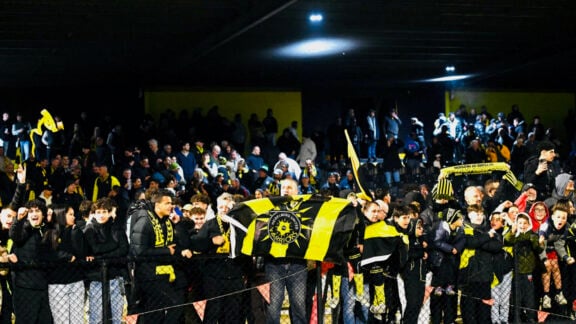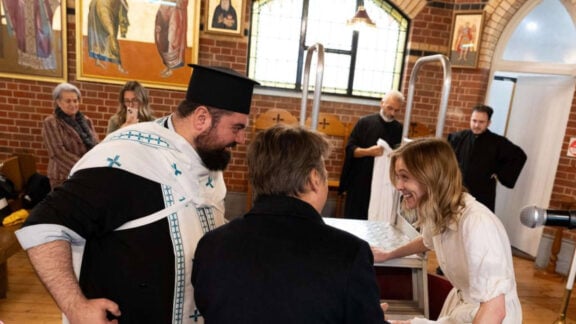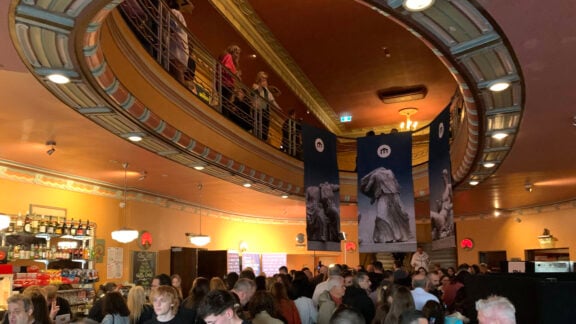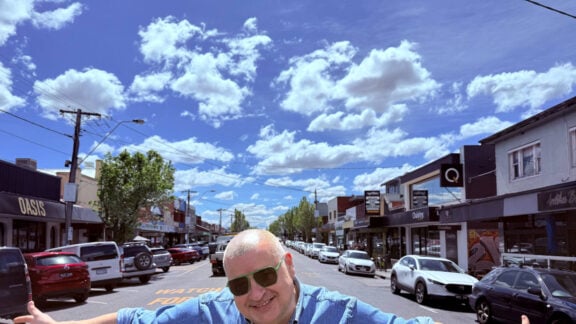In the beginning was the water. That’s why the camera of Kostas Nikas starts from and with the abyss of the ocean. Slowly it reaches and climbs up the sculpted rocks of some weathering shores, in order to end where all of us –one way or another– will eventually end, that is, within the silent land of the dead a cemetery.
This is where and how the independent Australian feature Sacred Heart by Kosta Nikas begins. But the camera suddenly decides to plunge and focus on a single human tragedy –to be honest, the human tragedy par excellence: death! Not just any death but the ‘unfair’ death –as we are so often accustomed to say– which means the death that always remains beyond the limits of our logical or moral acceptance.
Standing over the open grave of the wife he just lost to a hit-and –run accident (along with their unborn child), stands a young man. Opposite to him stands a Roman Catholic priest, the other main character of the film. In such a situation, as one can imagine, he constitutes a necessary evil, so to speak; an evil that alludes to the fact that something really evil is going on: the car accident cannot be seen as a random event, and thus one and only one can be fully responsible: God!
Sacred Heart deals with a problem that since Leibniz academics have dubbed ‘theodicy’; a problem that is quite old within the history of ideas, but remains consistently relevant, interesting and challenging. In the domains of philosophy, theology, or even literature, the problem of the trial (and condemnation or acquittal) of God –that is exactly what theodicy involves– in light of the overwhelming power of Evil has given rise to a vast repertoire of creative imagination as well as incredible inventiveness. This repertoire virtually covers everything from the non-existence of Evil to the non-existence of God. Nevertheless, neither Evil nor God have left us alone… However, in fields of art such as cinema one could say that the problem of theodicy –although present here and there– has not received as yet the systematic treatment that it deserves. This is exactly where Nikas comes in with his Sacred Heart, his debut feature film, filling in the gap with artistic and theoretical potency. Artistic potency, for he manages to turn –with only two actors in a single room– cinema into theatre and vice versa; and theoretical potency, for he finally manages to turn theodicy convincingly into anthropodicy.
Under the burden of loss, the young man explores/implores ways of justification. I wonder: of whom and for whom? His wife and child are no longer alive, and so what sort of meaning can their justification acquire? On the other hand, the social sentiment of justice does not give a damn about his personal drama, since society continues its course as if nothing has happened… or at least nothing unnatural… Whom does the protagonist want to justify? Or could we rather say what he really wants is to be justified before someone? But who would that be and what could possibly be the reason for such an action?
Resolutely and at the same time without any sense of hastiness, Nikas comes to the very centre of his film: the house of the protagonist, the protagonist himself, the heart of the protagonist, vis-à-vis the only other who is open to his call for justification, namely, the priest, the other Christian, the ‘God’ hypothesis.
However, something unpredictable happens: instead of being justified, the protagonist is being led to the verge of death through his attempted suicide. The priest appears just on time to save him. But it is here that the viewer starts being challenged: was not the priest already there? Or was the young man struggling with somebody else in his very house, in the deepest of his deepest selves?
During one of the talks I had with Nikas, he evocatively said to me: ‘for me the film has many layers, like an onion. I let the audience peel them one by one’. Undoubtedly, there are many ways in which one can read what takes place at the ‘house’ of the protagonist and takes up almost three quarters of the film. Under the influence of drugs, the disconsolate and enraged husband starts to exist otherwise or, to put it differently, starts to exist as a self. The priest (who is played by none other than AFI award winning actor David Field) is supposed to be paying him a visit in order to offer consolation and appease the spirits. What we see, though, is that he excites the spirits, all sorts of spirits.
The young husband is suddenly struggling with the voice of his conscience, his chaotic unconscious, the devil himself. For Nikas, moreover, ‘the house acquires the attributes of a third character’. Expanding on this, I would dare say that the house is brought forward as a metaphysical topology that reminds one of the invisible war fought by the ascetics (as St Nikodemus the Athonite would say), the heart as a battlefield of bad, obscene and blasphemous thoughts (as our Byzantine fore-bearers would say), or the cunningness of evil (to modify Hegel a bit).
Eventually, the battle is with one’s self and leads –unexpectedly– to a certain resolution of the whole drama. The young man bears within himself many a trauma from his Christian upbringing and background; lack of faith, guilt, sexual abuse. The death of his wife and their child triggers the vicious circle of his traumas, demanding justice. But in order to receive justice, one has to deliver justice. Thus a murder takes place in the film; a murder someone is required to commit sooner or later! This someone of course happens to be the young husband. Amongst the many and highly original insights that one comes across in this film –the scenario of which is spirited and sophisticated– we could say that Kostas Nikas puts forward the ‘God’ hypothesis as a necessity with regards to the construction of the self. It is with ‘God’ that self emerges; it is with ‘God’ that the self is obliterated; and it is with ‘God’ that one is realised afresh and constantly as a self. The question about Evil and the question about the existence of God are nothing but instances that characterise the self-affirmation of the self. If anything, through his Sacred Heart Kostas Nikas has proved that a hierophanic cinema not only is possible, but more to the point necessary –if not desirable.
The independent Australian feature Sacred Heart has been officially selected at the Shanghai International Film Festival on June 11th, where it will be having its world premiere and is expected to be screened in Australia later this year.
For further project information go to www.devilworks.eu/projects/sacred-heart or join www.facebook.com/sacredheartmovie
About the director: In 1999 Kosta Nikas produced Byzantium, the first Australian album of Byzantine music, released through Festival Records and recorded live in the Crypt of Sydney’s iconic St Mary’s Cathedral. He has written and directed stage plays and several notable short films including his acclaimed short film Light, which took out the Best Experimental film award at the Academy accredited Los Angeles International Short Film Festival and was also script translator for the award winning ABC TV Series The Slap. Nikas worked as a journalist before embarking on a film career, holding senior roles in electronic and print media, including editor of Internet Australasia, the country’s first internet magazine and Group Internet Publisher for several international journals for Euromoney Institutional Investor PLC (London/New York). He holds a Master’s degree in interactive and digital media from the University of Sydney, as well as a BA in Applied Communications from UWS.









